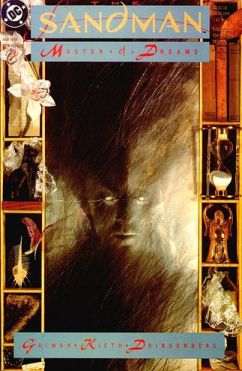Sandman:
Preludes & Nocturnes
(Issues 1-8)
Vertigo/DC Comics, 1989
Adult
240 Pages
![]()
![]()
It’s hard to believe that Neil Gaiman’s Sandman series is already over 20 years old. Since there will be more coming out soon, I thought I’d better review some of the classics.
All the stories from the original 75-issue comic book series are available in Graphic Novel format. The original comic books can still be found, and are not that expensive as back-issues go, but to get the full set might put you back $200-300 if you buy them all individually.
I remember why I loved this title so much when it first came out. It was ground-breaking. The protagonist was not a super-hero, but a demi-god. One of “The Endless,” he was the avatar of Morpheus, master of The Dreaming. The comic was a fairy tale rather than a hero’s quest. It was intellectual; it talked about society and psychology, and drew us in with its new approach to telling a fantastic, adult fiction story with pictures and word balloons. It was the reason comics became “graphic novels” and why they are now available in libraries instead of at garage sales.
In the opening chapter, an occultist and his coven attempt to capture death in a secret and forbidden ritual. But, being mere mortals, they screw it up. They get her brother Dream instead. Trapped for decades,
He patiently waits out the death of the magician who drew the circle. Then, years after that death, someone finally makes a mistake and the binding is undone. Morpheus exacts his revenge on the son of the magician, but he has been stripped of his tools, those that make him what he is. The rest of the story is essentially a quest to regain the objects that he placed so much of the essence of his power into.
Infinite dust, infinite dark… The Dreamworld is infinite, although it is bounded on every side.
The first storyline establishes Morpheus squarely in the DC Universe. The original Sandman from DC comics is given a nod, if only to distinguish the total un-relatedness of this series. Morpheus says he himself created the House of Mystery and The House of Secrets with his power, eternal roadhouses on the borderland filled with tales of the lost. We also meet Etrigan (from The Demon), John Constantine, (who helps Dream retrieve his bag of sand in chapter 3,) and Martian Manhunter (the last living member of the original Justice Society) on the way.
The way to the center is a slow spiral. One passes the houses of mystery and secrets –old waystations on the frontiers of nightmare…
One of the scenes here I still remember clearly, –in fact, it is one that truly influenced who I am, and that I think back to often, even two decades later. That takes a powerful story, and there were just so many in these comics, some not any larger than a single panel.
Dream has gone to Hell to challenge a demon for his mantle, a mask shaped like a fly-eyed aviator’s helmet, (reminiscent of the one worn by Geiger’s Alien pilot.) This is a world where the Devil, Lucifer, is referred to as Morningstar, and the agents our hero fights against have true underlying mythological or magical significance, as Gaiman is a true master of esoteric mythology.
In the system of Thelema, Choronzon is the Dweller in the Abyss, that great spiritual wilderness which must be crossed by the adept to attain mastery. Choronzon is there as the final obstruction. If he is met with the proper preparation, then he is there to destroy the ego, which allows the adept to move beyond the Abyss. If unprepared, then the unfortunate traveler will be utterly dispersed into annihilation.
— http://www.thelemapedia.org/index.php/Choronzon
The final stroke of the contest (not unlike an intellectual freestyle-rap showdown) between Morpheus and the demon Choronzon is one of those chilling, shaping moments. A poem growing in the darkest regions of existence. The Dream Lord brings it home by quietly explaining his importance to each of those present in order to win his release from the underworld.
…The dreams that pass through the Gates of Ivory are lies, figments, and deceptions. The other admits the truth. No one guards The Horned Gate any more. I remember the way of old. Once through it I can see my castle.
Preludes & Nocturnes is pretty much rated PG, save a few unsettling and gory pictures, until chapter 6, where Doctor Destiny has trapped a number of patrons in a coffee shop as if it were an old Twilight Zone episode. The storyline becomes quite adult very quickly as the insanity of complete power over human beings is revealed in the exploration of John Dee’s play. Morpheus has a head-on collision with Dee over his ruby, but there are limits to even his ability to fix things that have been savagely torn apart in the subconscious mind.
Taking a lap to cool down, Gaiman shows us that Morpheus can also feel depressed, where he is left after having fulfilled the goal of freedom he sought for so long. Dream is visited by his sister Death who takes him on a Dickensian romp to pull him out of his funk. In the end, we are as stoked as Morpheus is; thrilled with life and its possibilities, ready to be engulfed by the next adventure the Dreaming swallows us into.

